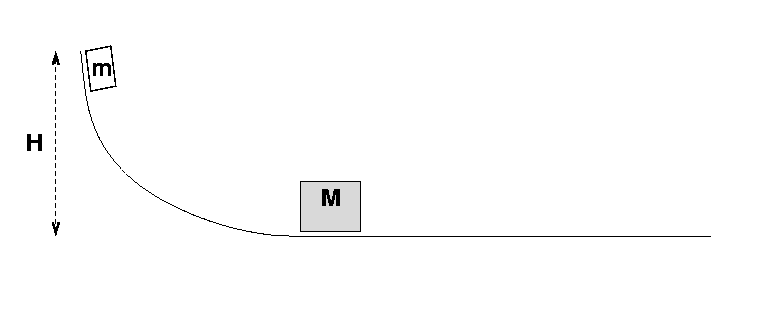 Copyright © Michael Richmond.
This work is licensed under a Creative Commons License.
Copyright © Michael Richmond.
This work is licensed under a Creative Commons License.
Practice for energy, momentum, and uncertainties

A brick of mass m = 2.55 +/- 0.03 kg sits at the top
of a frictionless incline of height H = 1.21 +/- 0.01 m.
Starting from rest, it slides down into an open cardboard box of
mass M = 0.81 +/- 0.02 kg.
The brick and box together then slide across a floor with
coefficient of kinetic friction mu = 0.23 +/- 0.02 .
- What is the speed v1 of the brick at the bottom
of the incline? Include the uncertainty in this speed.
- What is the speed v2 of the box-and-brick together
just after the brick slides into the box?
Include the uncertainty in this speed.
- How far does the box slide before coming to rest?
What is the uncertainty in this distance?
- What is the single largest contributing factor to the uncertainty?
Condensed guide to propagate uncertainties
- If you add or subtract two quantities, add the raw uncertainties
in each measurement
- If you multiply or divide two quantities, add the percentage
uncertainties in each measurement to get the percentage
uncertainty in the result
- If you raise a quantity to power N, multiply its percentage
uncertainty by N to get the percentage uncertainty
in the result
For an example of what I expect, look at
You can find full guides in several places:
 Copyright © Michael Richmond.
This work is licensed under a Creative Commons License.
Copyright © Michael Richmond.
This work is licensed under a Creative Commons License.

 Copyright © Michael Richmond.
This work is licensed under a Creative Commons License.
Copyright © Michael Richmond.
This work is licensed under a Creative Commons License.
 Copyright © Michael Richmond.
This work is licensed under a Creative Commons License.
Copyright © Michael Richmond.
This work is licensed under a Creative Commons License.